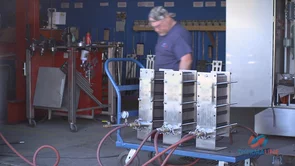Your equipment is the backbone of your business. Save money and time through proper maintenance and service.
For in-depth information on maintaining your plate heat exchanger check out our 9-part PHE maintenance video series. You'll learn how to take apart your unit, replace gaskets, understand your technical drawing and more.
Thermaline offers expert-level maintenance and service and can help get a maintenance schedule that works for your plant in place. Being prepared will minimize downtime and extend the life of your equipment. Contact us today to set up maintenance, service, or testing.

Understanding the ins and outs of your plate heat exchanger will help you extend your equipment's life while ensuring the safety of your product
What flow rate should I run for CIP?
The recommended CIP flow rate is 150% of the product flow rate.
Would you recommend running an acid cycle on the heat exchanger?
We don’t recommend a specific cleaning regiment as every process is different. Identical processes in different areas could require vastly different cleaning regiments due to variations in water mineral content and quality. All of our standard plate heat exchangers are made from solid 304SS/316SS plates and NBR or EPDM gaskets. We recommend consulting with your local chemical supplier to determine the best CIP concentration, temperature and duration. Opening your heat exchanger for visual inspection is advised to determine if a current CIP regiment is working sufficiently. On our website we have a video series that highlights how to open, inspect and manually clean your plate heat exchanger.
How often should I change gaskets?
Gasket replacement depends vastly on the product and process. Thermaline recommends keeping 10% of the required quantity of gaskets on hand at all times in case of gasket failure. If multiple gaskets fail within a short period of time, then it is recommended that all of the gaskets are replaced.
What is the torque spec for tightening my heat exchanger?
Rather than a torque spec, plate heat exchangers are tightened to a specified tightening range, which is a minimum and maximum dimension per plate. Refer to the drawing supplied with the unit, or contact Thermaline for your heat exchanger's tightening range.
Will gasket failure cause cross contamination?
No. All Thermaline plate heat exchangers are designed to leak externally in the event of gasket failure. Not only does this prevent cross contamination, it also is an immediate indicator that the gasket has failed.
Can I add plates to my heat exchanger?
In most cases, yes. Thermaline's engineering staff can recommend the maximum number of plates you can add to your frame or the minimum number of plates you should add to achieve the increase in heat transfer that you need.
How should I store my spare plates and gaskets?
Spare plates should be stored in their original container or hung up in a protected area.
Gaskets should be stored in an area sheltered from light at a temperature between 32ºF and 70ºF. If gaskets are stored below 32ºF they must be warmed above 32ºF prior to handling. They should preferably be stored flat. If space is restricted gaskets may be stored folded in half but care should be taken to avoid sharp bends which will cause weak points.
How do I replace a gasket?
- Remove the plate from the heat exchanger and remove the gasket.
- If removal of the gasket proves difficult, use a hot air gun to heat the gasket groove from the back. As the adhesive softens pull the gasket off with pliers. Alternatively, the plates may be dipped in liquid nitrogen and then knocked. The gaskets should crumble off.
- Clean the plate completely. Any remaining traces of old adhesive should be removed from the gasket grooves with a cloth. Use a solvent such as Toluene, Acetone, or MEK.
- If solid particles remain in the gasket groove, remove them carefully with an abrasive cloth
- Install the new gasket. (See PHE manual)
- Install the plate in its original position.
Check out our 9-part video series Maintaining Your Plate Heat Exchanger for details on gasket replacement and disassembling your unit.

